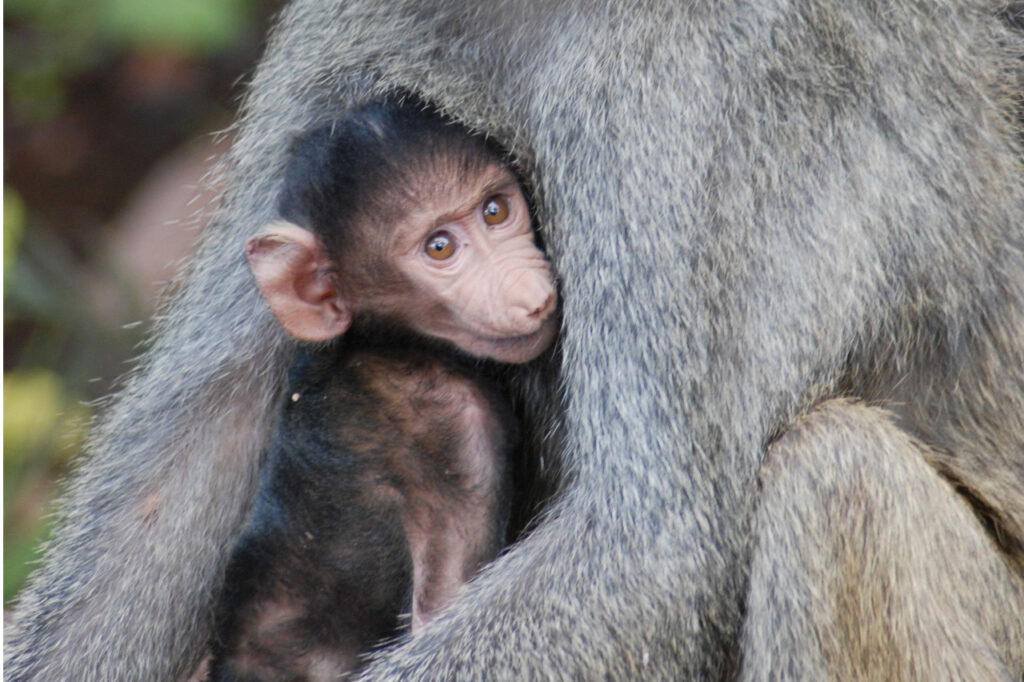[LUM#6] The origins of speech
Baboons emit sounds quite comparable to human vowels. And this despite their vocal tract being different from ours. A discovery that shatters dogma and suggests that the emergence of speech may be much older than previously thought.

How did our distant ancestors begin to speak? It's a thorny question, since we only have fossils, and no recordings. Until now, the theory widely taught for decades was clear. Only Homo sapiens could speak, anatomically speaking. Its low larynx would have played a crucial role in articulating distinct sounds. However, this low larynx is unique to man, as all our primate cousins have a high larynx. It was only after the acquisition of bipedalism that our ancestors' larynx began to descend over hundreds of thousands of years. According to the theory, this enabled them to start articulating once they had acquired the necessary cognitive abilities. The anatomical possibility of speaking was thus seen as yet another singularity for Homo sapiens in the animal kingdom.
Five proto-voyelles
In recent decades, this widely accepted theory had come under some attack. Human babies, for example, can pronounce vowels despite their high larynx. Neanderthals, too, who disappeared some 30 or 40,000 years ago, were not handicapped by their larynx for articulating... all the more so as it was undoubtedly located in the same position as that of modern Man. Today, however, this theory of the emergence of speech has been definitively disproved by a study conducted by several teams of researchers.
In recordings of 1,400 baboon vocalizations, many sounds are comparable to human vowels. Analyses of their acoustic properties and the way baboons articulate are formal. These primates emit proto-vowels, i.e. sounds with vowel-like properties, and can articulate five clearly differentiated ones: "a", "e", "o", "ou" and one close to "i". These correspond to the basic vowels around which most human languages are organized.
Speech building blocks
Our primate cousins can even combine two proto-vowels, to form "waou", for example, with the "w" as a first consonant. Why is this so important? Because these sounds are fundamental to articulate speech. Present in all human languages, they provide a framework for structuring syllables, essentially a consonant followed by a vowel. Baboons therefore possess the basic building blocks of speech.
" This is the first time that primates have been shown to have sufficient anatomical elements to speak," explains Guillaume Captier, surgeon and Professor of Anatomy at the University of Montpellier. " In other words, if we humans had the vocal tract of baboons, with our brains, our neurological control, we'd be able to pronounce vowels and therefore speak ". These monkeys, by the way, have exactly the same tongue muscles and vocal cords as humans. It is the positioning of the tongue in relation to the palate that is central to speech.
Continuous process
The story of the emergence of speech is therefore much older than previously thought. The necessary building blocks probably date back to our last common ancestor with the baboon, 25 million years ago. The first human to use spoken communication may therefore not have been Homo sapiens, which appeared around 200,000 years ago, but an earlier representative of the human race such as Homo habilis ( Evidence for a proto-vocalic system in baboons suggests pre-human speech precursorsin PlosOne, 2017).
Speech, then, is no longer reserved for the modern human. "Of course, we're not talking about language here. But baboons do have a speech system, in the sense that they use differentiated sounds," explains Guillaume Captier. " It's not anatomical limits that were constraints for the appearance of speech and language, but coordination and cerebral development". This was therefore undoubtedly a continuous process over hundreds of thousands of years(Which way to the dawn of speech?: reanalysis of half a century of debates and data in the light of speech sciences, ScienceAdvances, 2019). A major step has thus been taken towards a better understanding and, one day, the reconstitution of the formidable epic of the appearance of human speech and language...
What is a vowel?
When a vowel is pronounced, the airflow flows freely through the mouth and nasal cavity, encountering no obstacles. The result is a clear, harmonious sound. For a consonant, on the other hand, air encounters an obstruction. The consonant results in a noise: clicking, hissing, whistling, rolling and so on. What actually happens when we produce a vowel? The sound comes from the vibration of our vocal cords. At the same time, the tongue, soft palate, teeth and lips come into play to modulate the sound. Nasal vowels (as in "bread", "white", "mountain"), for example, are pronounced with the soft palate lowered: air passes through the mouth and nose. Vowels can also be studied acoustically, using spectral sound analysis. In this way, they can be recognized by their frequency and amplitude - as was done in the study of baboon vocalizations.
UM podcasts are now available on your favorite platforms (Spotify, Deezer, Apple podcasts, Amazon Music...).